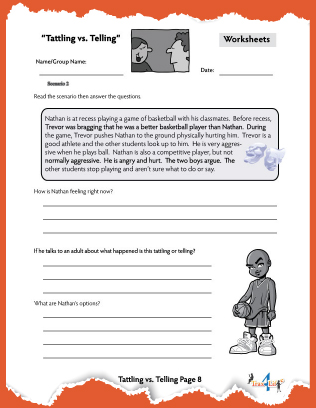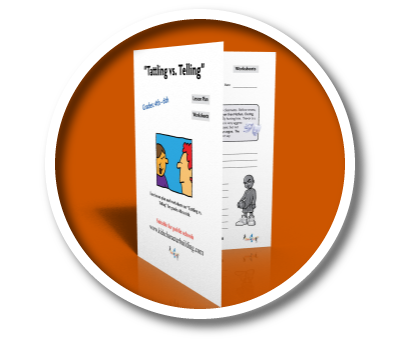Easy Lesson Plan on Tattling vs Telling for Grades 4th to 6th.

Introduction
An essential step in a child’s development is knowing when to report to an authority figure. No one likes tattling, yet if people do not report injustices or wrongs, everyone suffers. The determination of when and what to report can be confusing especially as children struggle with moral development. This lesson provides a simple framework that can be used to decide if an action needs to be reported.
Teacher Preparation
Teacher prepares situation and scenario cards.
Teacher Preparation
- Buzzer or bell
- Situation cards
- Scenario cards
- Journals
Lesson Objective
- Students will understand the difference between tattling vs. telling.
- Students will determine when to get an adult involved.
Explanation (5 Minutes):
It is sometimes difficult for students (and adults, for that matter) to clearly understand the differences between “tattling” and “telling”. “Tattling” is when you are intentionally trying to get another student in trouble for something that they did which doesn’t harm another in any way. “Telling” involves going to an adult and informing them of another’s behavior that has really affected you (or someone else) on some level. Maybe your feelings have been hurt pretty badly, you feel scared for your own safety, or you have been completely humiliated. Sometimes, problems do not go away on their own and the best option is to inform an adult.

Discuss with students (15 Minutes):
Discuss the following statements with your students:
- What is the difference between tattling and telling?
- What are the consequences of tattling?
- What are the consequences of telling?
- Have you ever had a difficult time knowing whether to tell a teacher or not to tell?
- Have you ever decided to tell and the adult told you to quit tattling?
- Have you ever decided not to tell and you got in trouble for not telling?
Action (20 Minutes):
Tattling Game
Materials: Buzzer or bell, situation cards.
Rules: Have two students come to the front of the class and stand facing each other with a desk between them, place the bell in the middle of the desk . Both students are to stand with their hands behind their back. Teacher reads the statement on the situation card. The first student to ring the bell identifies whether the statement is tattling or telling.
The student will then state why (i.e. Randy has a knife, is telling because he could hurt himself, someone else or damage something). Students must wait for the teacher to finish reading the card before they can ring the bell. The student to answer correctly wins. If a student answers incorrectly, their opponent has the opportunity to steal (answer correctly). Both students are congratulated as they return to their seats. The next two students are called up to the desk. If the classroom has an uneven number of students (everyone has had a turn except for the last student) that “lucky student” gets to challenge the teacher.
- You: Solomon is lying about how many baskets he made in the game. (Tattle)
- You: Ashley is throwing leaves. (Tattle)
- You: Peter hit Blake. (Tell)
- You: Caroline ran out into the street. (Tell)
- You: Katie brought her phone to school. (Tattle)
- You: Juan took a third graders lunch money. (Tell)
- You: Kaylee won’t play with me. (Tattle)
- You: Amanda was teasing Amy and now she’s outside crying. (Tell)
- You: Randy has a knife. (Tell)
- You: Molly says I’m not her friend anymore. (Tattle)
- You: Glen is throwing rocks. (Tell)
- You: Ray pushed Abe down on the bus. (Tell)
Discussion (5 Minutes):
After the game, thank the students for their participation. Ask the class the following questions and briefly discuss:
- What could happen if you didn’t tell the teacher about a dangerous situation?
- If you needed help, would you want your friends to tell a teacher?

Scenarios (30 Minutes):
Have student pairs join with other pairs to form groups. Pass out scenario cards to groups. Ask students to read the scenarios together as a group then answer the questions. After the groups discuss, have groups present their answers to the rest of the class. (See accompanying worksheets for this activity.)
Scenario 1
Nikki is new to the school and eager to make new friends. She soon becomes friends with Jennifer and they start sitting next to one another at lunch. Jennifer’s best friend Maria starts to worry that the new girl, Nikki, is going to take her friend away from her, so Maria starts acting mean toward Nikki. She teases her and then gets a few other girls to tease her. Within a week the teasing has turned into bullying and Nikki now hates coming to school. Jennifer wants to tell someone about the bullying, but she does not want to get a reputation as a “tattle-tale.”
- How is Nikki feeling right now?
- If she talks to an adult, is this tattling or telling? Why?
- Nikki wants the bullying to stop. What are her options?
- What could others to do help Nikki in this situation?
- Nikki wants the bullying to stop. What are her options?
- Jennifer doesn’t like feeling in the middle. What are Jennifer’s options?
- How is Maria feeling right now?
- What might happen if no one tells about what is happening to Nikki at school?
Scenario 2
Nathan is at recess playing a game of basketball with his classmates. Before recess, Trevor was bragging that he was a better basketball player than Nathan. During the game, Trevor pushes Nathan to the ground physically hurting him. Trevor is a good athlete and the other students look up to him. He is very aggressive when he plays ball. Nathan is also a competitive player, but not normally aggressive. He is angry and hurt. The two boys argue. The other students stop playing and aren’t sure what to do or say.
- How is Nathan feeling right now?
- If he talks to an adult, is this tattling or telling? Why?
- What are Nathan’s options?
- Why might it be hard to tell an adult in this situation?
- Why might it be important to tell?
- What could others do to help Nathan in this situation?
- What might the other kids be thinking about playing with Trevor
- How is Trevor feeling right now?
- Do you think it is okay for Trevor to keep playing rough, hurting others and not playing by the rules?
- What might happen if no one tells about what is happening at recess?
Review (5 Minutes):
- If another student does something you don’t like, who can you tell?
- Tell the other student how that action made you feel.
- If you did something that another student didn’t like, what can you say?
- What can I do to help you feel better?
Assessment (15 Minutes):
Have students write about one or more of the following prompts in their journals:
- If another student does something you don’t like, who can you tell?
- What can you do to support your classmates if they need to tell?
- What can the adults in the building do to better support students when they need to tell?




